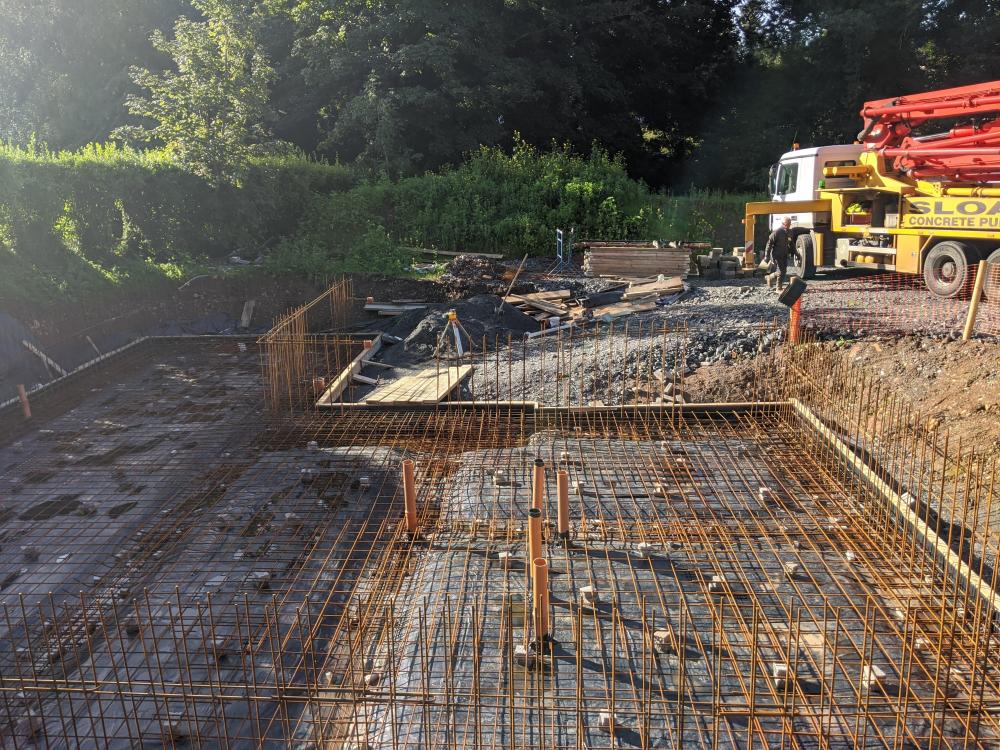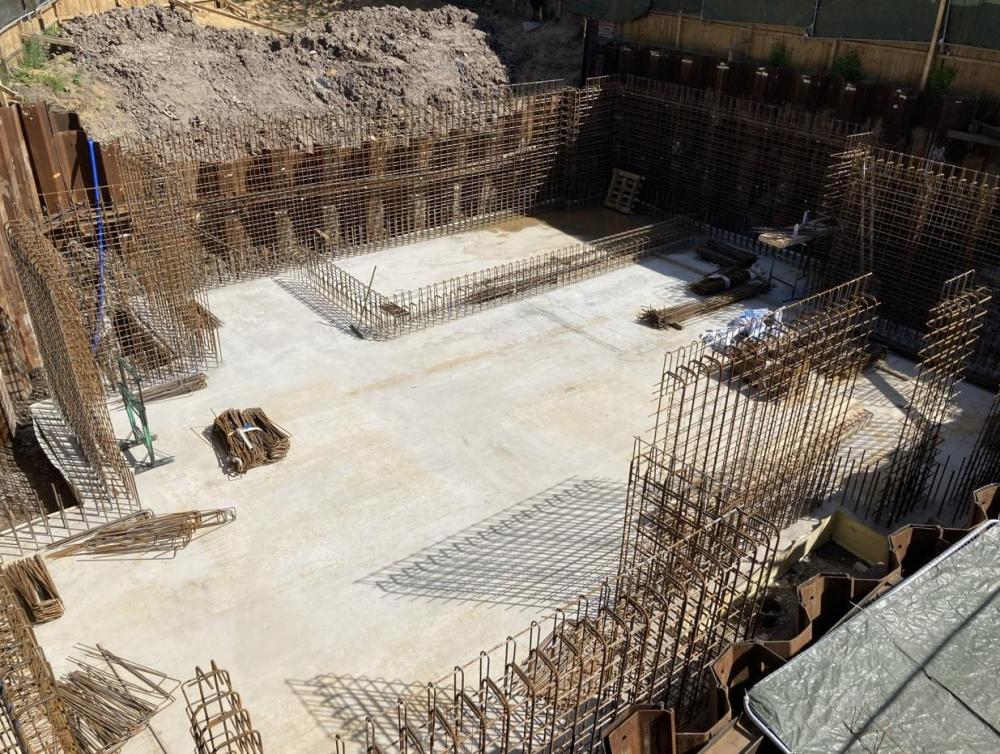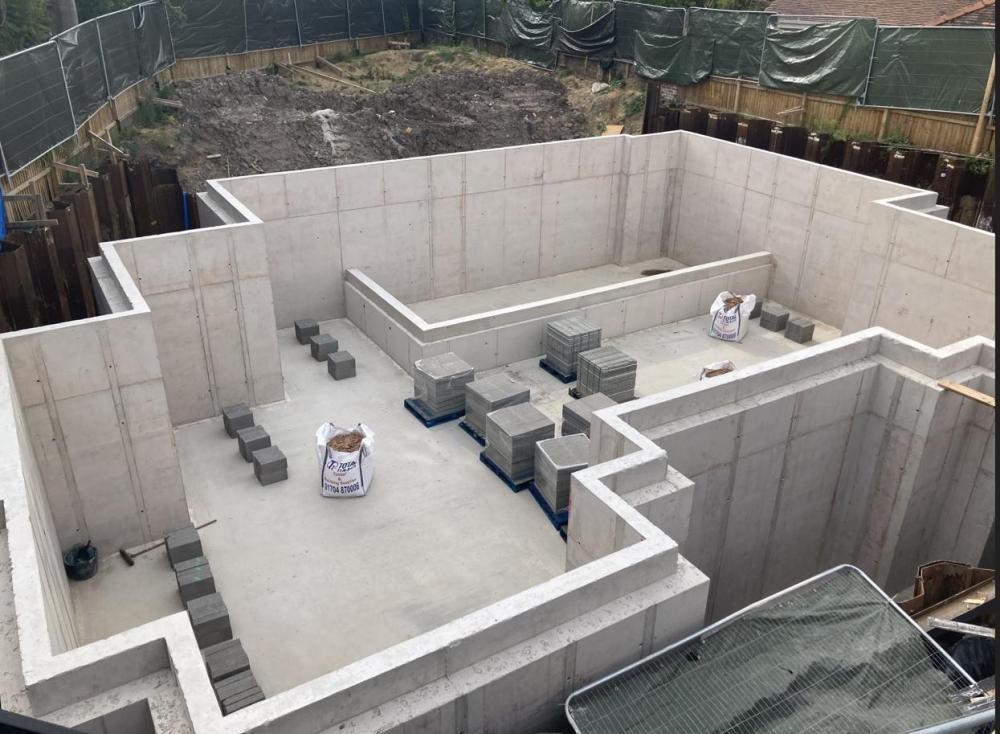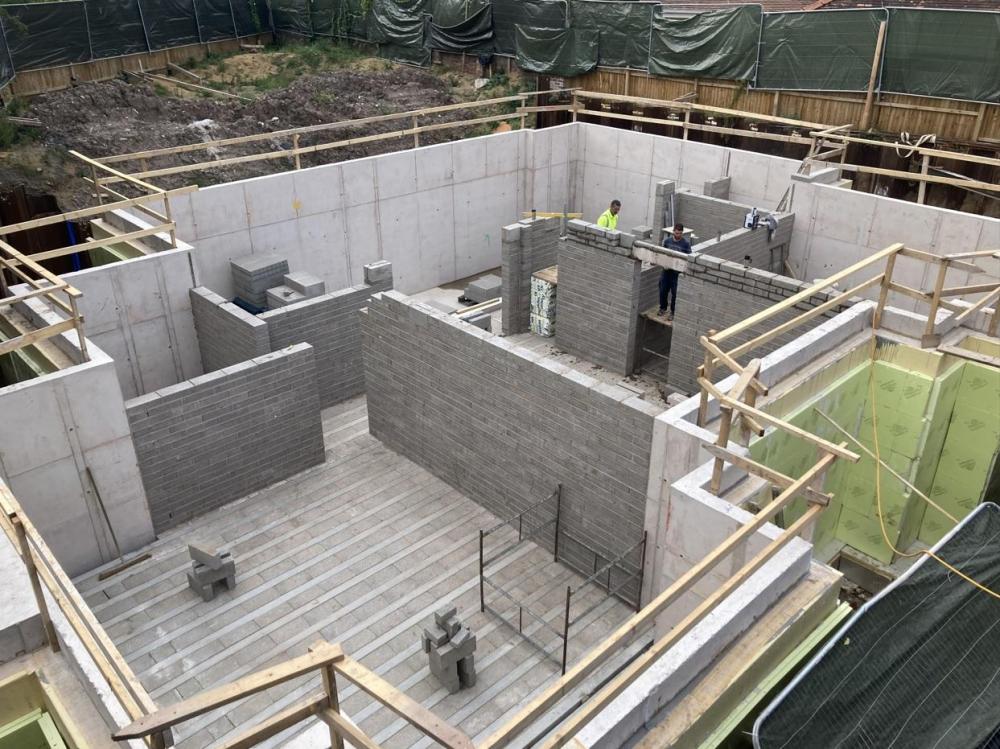Leaderboard
Popular Content
Showing content with the highest reputation on 09/29/22 in all areas
-
Listen to this guy, he gets it. Life is too short to worry about this....!!! Overboard, and within a couple of weeks all is forgotten.4 points
-
200mm of mineral wool could never match the U-value of 200mm PIR - if 200mm was what is required then it will not be enough, if however, it was calculated that it would work at 100-110mm PIR, which equates to a U-value of 200mm mineral wool, but 200mm PIR was spec'ed to get a really well insulated envelope, then there is a chance a good 200mm mineral wool will work. If you can find your original insulation calcs, you can probably work it out and submit your rational, there is a chance they will accept it. If there is 200mm mineral up there, and we say that is comparable to the 110mm PIR, then you may be able to get it to work, if it came to it, with 40mm insulated plasterboard on top of what you have - not ideal by any stretch but better than ripping it all apart. Or you might be able to do notional calcs and get other areas to work better than others thus balancing it all out.3 points
-
As promised another update, following many tweaks and a firmware upgrade from Solis. So the existing problems were: Whenever the battery isn't at 100% SOC, it pulls an amount of power from the grid, somewhere between 60W and 100W Even when the battery is actively charging, it still pulls the same 60-100W from the grid, regardless if there is enough PV power to charge the battery and cover loads at the same time. Once the battery is 100% SOC and im generating PV more than my load, I import 0W. Pulsating loads (such as induction hob) the unit can find hard to track, due to their pulsing nature, and the delay in reading the CT clamp and acting upon it. The firmware upgrade was to fix the pulsating load issue, it doesn't completely resolve it, however it is much better tracked now. Solis reduced the polling time for the CT, so it is polled more often than before. The problems with the excess import of between 60-100W remained, however Solis put some variables in the new firmware which allowed them to place an offset, we tried many different values and eventually stopped at a 65W offset, now the grid connection fluctuates between +40W and -50W which overall has fixed the issue as good as can be without draining too much of the battery power. Oddly since adding the second US3000C module, my overnight usage (no PV input) has dropped from around 0.35kWh to 0.2kWh, why i'm not sure but no complaints from me there!! Now have 6.6kWh of usable capacity, to note the original US3000C module had just dropped to 99% SOH, manual states to use the newer module as the master, which I did, so its now once again showing 100% SOH, and the 1% drop of the older module is handled internally. Upon connecting the new battery, the old battery appeared to receive a firmware upgrade, as it restarted a few times before staying on. Current yearly graph is looking good, still exporting a lot of power, but at least I'm using what i can now: Shown above is a daily example of the battery charging and discharging. This was after a particularly cloudy day which only just saw me reach 100% SOC for a mere moment. The negative battery power denotes power draining from the unit, with positive being a charge. This is the corresponding grid data for the same day. Previously (March 2022) I reported total import of 48.3kWh. Clearly its impossible to compare with another month, and we will have to wait til March has been and gone once again, however here is the monthly data from April onwards: April - 41.2kWh May - 18.4kWh June - 17.1kWh July - 18.9kWh August - 18.1kWh September (So far) - 18.0kWh The tweaks to the system were finalised on May 5th, just checked my emails from Solis and that was the last contact, so April shows another month before the changes. Full credit to Paul Carpenter, the European Engineering Manager as Solis for sticking with me on all these changes til we found the sweet spot! Hope this provides some good info for someone out there thinking of installing battery tech. I'll post another update at the 1year point, though probably 1year from the tweaks, so May next year, and then I'll also be able to comment on my AQ for the import.2 points
-
Appears metal open web rafters are similar to solid wood.. http://www.greenbuildingforum.co.uk/newforum/comments.php?DiscussionID=163572 points
-
I'm pretty sure open web joists would have better thermal properties than solid (eg less thermal bridging). I'm sure the makers would answer that question asked on its own. Might even be on their Web site somewhere. So perhaps see if the calculation for solid timber rafters is OK and add a comment that open web will be better.2 points
-
That sounds very wrong. What's the reason? The ICF walls will have vertical reinforcement bars and these should tie in to the foundation slab. By the sounds of the mesh requirements this is a substantial structure and I'm amazed there is nothing tieing the walls to the slab. Here's our slab before the pour. Note the vertical bars at 200mm centres. It's a basement, but the standard would be a single bar every 1200mm for a single story.2 points
-
Just make up some bullshit to keep the BCO happy. a signature is all they are looking for to pass the blame elsewhere. just make sure you do the remedial works like the overboarding.1 point
-
The majority of the ‘nuisance’ sound / noise will be from the water hitting the tray / floor. Acoustic insulation under there is a good idea, plus any discharge pipework can be sound deadened if over a bedroom. Current clients new build, where I used Killmat over the waste and soil pipes. Takes a lot of the high frequency noise ( sound of water tricking ) away. As I’m doing a turnkey whole of house service I know I’ll be on the hook for any “issues”, so I’ve gone belt and 2 braces on the 1st floor bathrooms and the music / piano room to keep things as ‘quiet’ as possible. 🤞1 point
-
1 point
-
Oh yeah, but £150 on a new epc calculator will resolve that. Likely to take a couple of weeks, they're all busy with the new regs changes....1 point
-
1 point
-
It's quite common to mitigate cold bridging by having another layer of PIR (e.g. 50mm) over-boarding the underside of the joists. Was this not on the drawing?1 point
-
Thanks Chanmenie, >>> Company called Subteno From their website, they look like proper engineers . >>> but I do completely understand having someone local to oversee things and if there was a local SE that specialised in insulated slabs maybe I'd have given them an opportunity. but, as with a lot of things in the building game, that's not how they've always done it and so I didn't find any. Understand - I've found that once you start looking at more specialised skills, there may only be one or two in your county - and that's if you're lucky. Alan1 point
-
If they don’t have the staff they can’t be in two places at once. Don’t forget Building Control are not a clerk of works or contract inspection service - they can only see what is available for inspection on any given day. As for testing the drains a bucket of water shouldn’t be too hard to find on a building site!1 point
-
200mm PIR spec'd in roof is really significantly more then regs, especially on a refurb.... That alone doesn't seem right to me!! Get 40mm (ish) Insulated plasterboard over boarded and get on with life!!1 point
-
This is one of the suggestions from the architect, he said getting a SAP calc done for the whole house and not just the roof. But as you said, the real problem is the poorer insulation. We can't do 75mm as it will be below window frame level, but perhaps 37.5mm insulated plasterboard may be enough1 point
-
If 200mm PIR was specified was that what you paid for ? I believe 200mm PIR would be considerably more expensive and take much longer to fit, therefore the builder has made quite a bit more money by using mineral wool1 point
-
Mars bars or bits of broken pavers. You'll soon. Figure out how many you need once you start walking on the mesh. Min every 1200mm, double that at the edges.1 point
-
Best option might be a couple hundred quid on an independent EPC. Because ultimately that's what building control need to prove that you've met that part of the regs. Give him/her the drawings and explain the actual build up in the roof so they can assess the buildings overall performance. Personally, I'd be asking the builder to add 75mm PIR under the joists and renboard, which should get you close to what was specced. You have to remember that you'll be paying for this cockup for years and years to come through higher energy bills.1 point
-
1 point
-
Love to see how they would do a drain test ..!!! Annoying that they charge you £250 for inspections and then it’s down to sending your photos … given they also want to inspect trenches before a pour, what’s the SLA on responding to you sending photos1 point
-
Not sure about the requirements in Scotland but certainly the new Appr Doc L for England requires photographic evidence of a lot of the works. Failure to do so is viewed as a non-compliance with the Regs and can also impact the SAP assessment as the assessor needs copies of the photos too as part of the 'as built' assessment.1 point
-
Just tighten them until you feel you aren’t really pushing or pulling on the spanner. A larger spanner will offer more torque so go with your gut feeling and pinch up afterwards if necessary. I just put a bit of spit on the rubbers of the inserts tbh.1 point
-
Taking photographs is really a last resort by Building Control - not liked by officers and open to abuse. However lockdown necessitated the use of photographic evidence and the inspection notes would reflect this. Im surprised that the BCO hasn’t asked for a video call - this is often a very useful exercise and a real-time inspection can give the BCO an opportunity to review and comment on the works before you proceed to the next stage. If your BCO is asking for photographs I would suggest that they really don’t have the resources (at the moment) to carry out inspections to all properties. I would suggest that you photograph everything - twice. I would also suggest the following: Commencement. A video is quite useful showing the commencement of any excavation in relation to the wider site. Again photographs of the site before, during and after any excavation works. Foundations. Photograph all trenches showing the site in context so that there is no ambiguity on the location of the foundation trenches. Photograph the width and depth of a few typical trenches - internal wall trenches may be wider than the external wall trenches. photograph the base of a few trenches to show the composition and material of the sub-base. Sub-Floor. Photograph the sub-base being placed in stages showing the materials used and the depth of hardcore placed. A gain make sure some photographs show the works in context with the wider site. Show the sub-structure being built, in context and with measurements. Photograph all DPMs or radon barriers being placed along with overlaps and sealed joints. Drainage. Photograph the layout showing the location and inside of all ICs or MHs - dimension the cover and show the location of all SVPs. Take a video of the drainage being tested to show that the falls are satisfactory. Superstructure. Again - photograph everything with dimensions. Photograph the inside of all cavities and show the location of wall ties, insulation and all DPCs. Photograph the sizes, strength grade and centres of all floor joists, rafters, purlins, trusses - the list is too extensive to mention but if it doesn’t move photograph it. Completion. Start at the site entrance to show that the disabled access complies. Photograph the width of the PA door complete with a dimension. Photograph the location of all SAAs, HAAs and CO alarms. Take a video to show that they are working and interlinked. Video all extract fans working and show that any PIV and MVHR systems are installed and working satisfactorily. Photograph all EEWs showing the width and height. Photograph the roof space to show that it is insulated. I have probably missed a shed load of stuff. However I would strongly suggest that you get confirmation each stage of what your BCO wants you to photograph. Then I would send all photographs and videos and would ask for written confirmation that what you have submitted is satisfactory and that you can move to the next stage of your build. Hope this helps in some way.1 point
-
https://www.builderdepot.co.uk/flexseal-50mm-58mm-flexible-straight-coupling?gclid=CjwKCAjwhNWZBhB_EiwAPzlhNkWMZAgml2fWx4zggaPrdhIFWmBdJI4qMMdRpPG2ATdI0qk5WPq4FBoC85oQAvD_BwE1 point
-
I think I’d want a rubber coupler with say 2x stainless jubilee clips either side to do that transition. If that spigot ever shears you’re up………ahem………💩 creek.1 point
-
You need plastic pipe cutter and a reamer, the reamer cuts the end square with a chamfer and re-rounds the pipe. The eurocones just slip in the end of the pipe. If your forcing it you may have the wrong sizes. The assembly is done dry, i didn't use or see the need for any lube.1 point
-
1 point
-
Even if you succeed in getting the application declared invalid is another valid one will follow in 21 days. Concentrate on studying the plans and trying to find a valid planning reason to object.1 point
-
I had this with Angus council . My contractor was supposed to be doing it and did not bother his arse. Luckily I had taken loads of photos saved to cloud storage so when they asked for the photos at the end of the build I gave them access. They were also a bit vague with exactly what they wanted just asking for detailed photos or video of Foundations Superstructure Drainage (Foul) Drainage (Soakaway) For superstructure I made sure included any steel work and trusses going in as well as windows. The issue we had is that they wanted to see insulation before the the pasteboard went on and as ours is closed panel so we had to get info from the manufacturer instead.1 point
-
About £60 of parts and labour, so not much. That would be paid back in about in about 3 years. It feels quite 'sensible' from a fast hot water angle though. Cheaper and probably less heat inefficient that a circulating hot water supply to the tap.1 point
-
I’m guessing it’s a private company I wouldn’t be happy with that Even the warranty companies come out and pretend to be interested1 point
-
Can you have this work carried out under your buildings insurance? Subsidence can be expensive to remedy so if you make a claim, make sure the works are comprehensive and covered by long term guarantee.1 point
-
I would ask them for clarity of what they would like to see, at what timescale, and if you can proceed without prior approval of the photos.1 point
-
Including them means you can do them first if you want the storage space while building. If you don't include them, you don't officially get permitted development rights until the house is complete.1 point
-
I think we used CW1326 cable with at least 2 pairs (eg 4 wires). We ran ours direct in the ground but I probably should have used a duct. We left a coil at the bottom of the pole long enough to reach the top with 5m spare for luck. My electricity meter box is on the outside wall of my office with the CU in a walk in cupboard in the office. So we ran the BT cable into my meter cabinet then into the office following much the same route as the meter tails. Not sure if its a good idea but works for us. The office cupboard has our BT master socket, modem, 16 port hub, DECT phone base station, burglar alarm, TV distribution amp and more in it. I think there is an (optional?) Building Regs Approved Document showing how its meant to go into the house via a duct.1 point
-
I don't know about using Routers as WiFi Access Points. I guess they would work. Perhaps need to turn off DHCP so devices get an IP from your main router managing the guest network? You can get WiFi access points for £20 - £40 on Amazon but I've not used them. Perhaps others here have. Example: TP-Link TL-WA901N 450 Mbps Wireless N Access Point, Passive PoE Power Injector, 10/100M Ethernet Port.. £20.49. https://www.amazon.co.uk/TP-Link-TL-WA901N-Wireless-Injector-Ethernet/dp/B087MSF7BR/ref=sr_1_1?adgrpid=53310796295&gclid=CjwKCAjw4c-ZBhAEEiwAZ105RSuejHOnZC2FA83urbj3nXcfmYXfnfcfR19_iwfBGee8GOj2YL9PxxoCn9oQAvD_BwE&hvadid=259016914938&hvdev=t&hvlocphy=1006818&hvnetw=g&hvqmt=e&hvrand=10865873223415071343&hvtargid=kwd-361530570237&hydadcr=5058_1827822&keywords=wifi+access+point&qid=1664402731&qu=eyJxc2MiOiI0Ljk3IiwicXNhIjoiNC40MCIsInFzcCI6IjQuMTMifQ%3D%3D&refinements=p_36%3A-3000&rnid=428432031&sr=8-11 point
-
We are using the Alwitra Elevaon V stuff. We have 64sqm to cover with one rooflight. I’ve seen it fitted on a few buildings and it looks very good.1 point
-
No, but keep in mind it was just a surface water condition that was holding us up, we are harvesting the majority of our rainwater so we couldn't have done much more. I expect that a drainage plan might not have the same outcome. My guess is that they're clearing some of the easy ones, thank god. We're so pleased to be able to make some progress and just hope they're able to bring relief to some of you that are in the same situation.1 point
-
1 point
-
A structural engineer is someone who is a Chartered Engineer (CEng) and a member of either the Institution of Civil Engineers (MICE) or of the Institution of Structural Engineers (MIStructE). Their post nominal would be CEng MICE or CEng MIStructE. Is this to check the house generally or just for the design of the crack stitching bars?1 point
-
Fancy plasterboard. https://inspectapedia.com/structure/Gyp_Rock_Sheathing.php Fires don't like it. Bugs don't like it. Helpful in wildfire and bug country. I wish I had known about it - I'd have cut in diagonals for bracing, then used this outside the timber frame THEN stuffed in insulation at our leisure THEN done the airtightness layer. And not worried about the effing bugs that effing eat their way through the breathable membrane that we did throw over the timber frame; or the effing pine marten that effing decided to shred it's way through the membrane and into the insulation to overwinter. I think this is the same kind of thing and can sit outside for 6 months until the cladding is fitted: https://www.british-gypsum.com/products/board-products/glasroc-x-sheathing-board-125mm#technical-description1 point
-
Many councils have an SPD with a wide variety of names like "Seperation of Dwellings SPD" or "Separation Distances and Amenity SPD". Find out if your council has one and check if you comply.1 point
-
1 point
-
The only reason I’ve ever recommended one is when a customer wouldn’t listen to me that they wouldn’t get planning. I mainly did it so they would go away. in terms of cost you get far more for much cheaper by putting something half decent and considered in for full planning. the planners give you feedback, and probably a free go anyway, so why wouldn’t you just go in for that? Preplanning gives you zero confirmation of anything really, maybe points you towards relevant policies but I can find those for you as a layman.1 point
This leaderboard is set to London/GMT+01:00
















